An intelligent agent is a software program or system that can sense its surroundings, make choices, and perform actions to achieve specific goals. Artificial Intelligence Intelligent Agents gain insights from their observations, store their activities in memory, and modify their behaviour accordingly. Different intelligent agents use various methods to solve problems and achieve their goals.
Artificial Intelligence Intelligent Agents
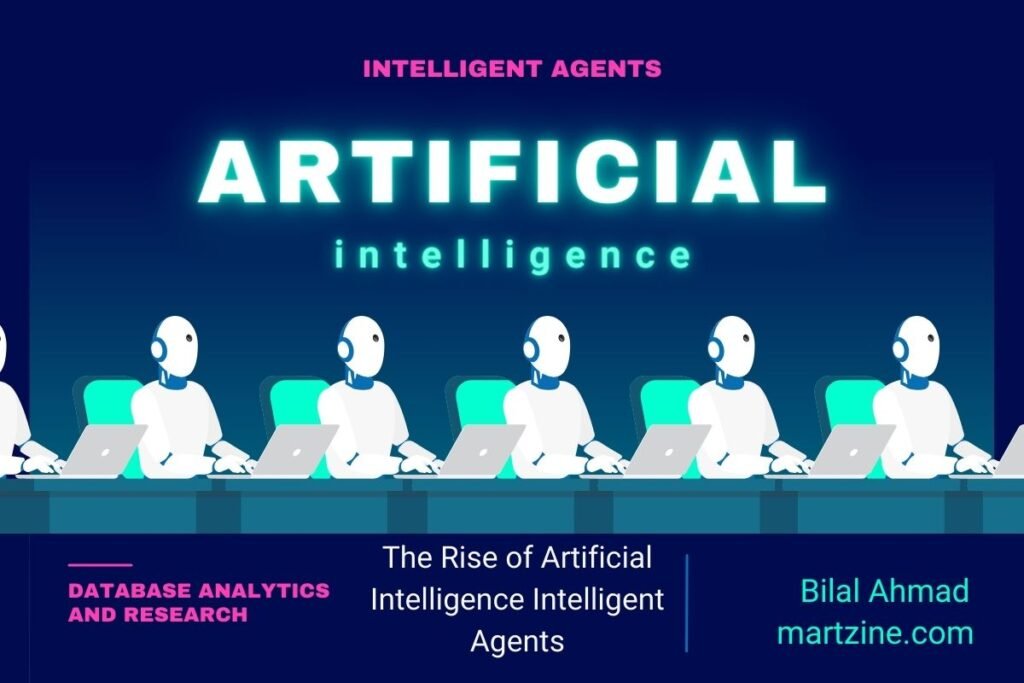
The top 5 kinds of intelligent agents in artificial intelligence are:
Simple reflex agents
These agents react based on what they perceive at that moment without any memory of past events. They have rules that tell them how to respond to different situations. For instance, a simple reflex agent for a self-driving car might have a power that says, “If there is a car in front, then stop.”
Model-based reflex agents
These agents remember their past experiences and use them to understand some aspects of the real world. They have a model of how the world works and how their actions affect it. For example, a model-based reflex agent for a self-driving car might have a model of the road, traffic, and weather and use it to plan the best route.
Goal-based agents
These agents have a specific goal they want to achieve and act in a way that is likely to get them closer to it. They use a search and planning method to find the steps of actions that lead to the goal. For example, a goal-based agent for a self-driving car might aim to get to the destination as fast and safely as possible and use a map system to find the best route.
Utility-based agents
These agents have a utility function that measures how good a situation is and tries to maximize it. They consider the costs, benefits, and goals of different actions and results. For instance, a utility-based agent for a self-driving car might have a utility function that balances the trip’s speed, safety, comfort, and fuel consumption and uses it to compare different options.
Learning agents
These agents can learn from their experiences and improve their performance. They have a learning part that allows them to update their knowledge or agent program based on feedback or new data.
They also have a performance part that selects actions, a problem generator that suggests actions that will lead to unique and valuable experiences and a critic that checks the actions and provides feedback. For example, a learning agent for a self-driving car might use reinforcement learning to improve its driving skills by learning from its driving and the rewards and penalties it receives.
Artificial Intelligence Intelligent Agents Designs
The design of an intelligent agent depends on various factors, such as the type of environment, the kind of agent, the goals of the agent, and its performance. Some of the essential properties of the environment are:
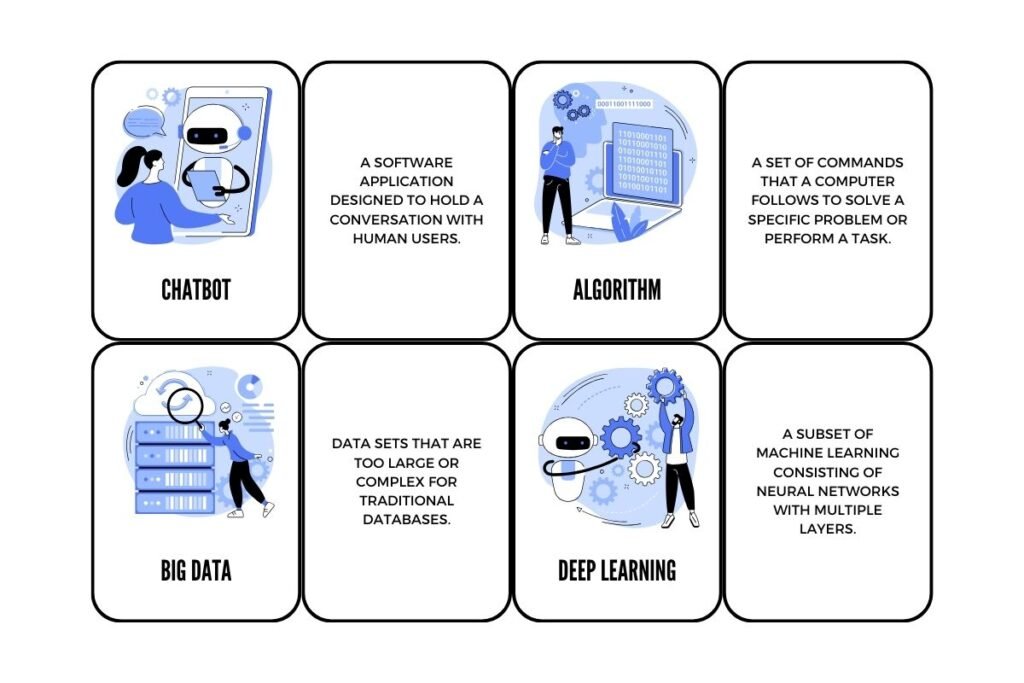
Fully observable vs partially observable
An evident environment is one where the agent can see the entire state of the environment each time. In contrast, a partly visual climate is one where the agent can only see some parts of the environment or the data it receives is noisy or incorrect.
Deterministic vs stochastic
A deterministic environment is one where the next state of the environment is entirely determined by the current state and the action taken by the agent. A stochastic climate involves some chance or randomness in transitioning from one state to another.
Episodic vs sequential
An episodic environment is one where the agent’s experience is divided into separate episodes, and each episode consists of the agent observing and then taking a single action. The quality of the action depends only on the episode itself. In a sequential environment, the agent’s experience is continuous, and the current decision could affect all future decisions. The quality of the action depends on the entire sequence of actions.
Static vs dynamic
A static environment is one where the environment does not change while the agent thinks. A dynamic environment is one where the environment can change while the agent is thinking. The change can be due to the actions of other agents or natural events.
Discrete vs continuous
A discrete environment is one where there are a limited number of different, clear states, percepts, and actions. A constant environment has infinite possible states, percepts, and actions, which may vary smoothly or analogue.
Single-agent vs multi-agent
The agent is the only entity affecting the single-agent environment. A multi-agent climate is one where other agents can affect the environment and interact with the agent. The other agents can be friendly, unfriendly, or neutral.
The Architecture Of Intelligent Agents
The Architecture Of Intelligent Agents The architecture of an intelligent agent is how the agent is built inside. It has parts that do the agent function and program. The agent function is the math way of saying the best way to go from what the agent sees to what the agent does. The agent program is the natural way of doing the agent function on a machine.
There are different kinds of architectures for different types of agents, such as:
Table-driven agent
Table-driven agents use a table that has the action for every possible thing the agent sees. They are easy to make but could be better for big or complex environments, as the table gets very big with the number of things the agent sees and does.
Logic-based agents
These agents use a knowledge base with facts and rules about the world and a logic engine that makes new facts and answers from the old ones. They use logic to decide what to do based on their knowledge and what they see. They are suitable for clear and fixed environments but may need help with doubt, differences, or lack of knowledge.
Reactive agents
These agents need an understanding of their goals. They depend on rules that directly go from what they see to what they do. They are fast and robust but must improve their abilities and change. They cannot plan or learn from what they do.
Belief-desire-intention (BDI) agents
These agents have a clear picture of their beliefs (information about the world), desires (goals to reach), and intentions (plans to do). They use a practical thinking process that involves picking the most critical and possible desires, making and choosing the best plans to reach them, and doing and watching the plans. They are suitable for changing and unsure environments but may need help dealing with complex and opposite goals and plans.
Neural network agents
These agents use a network of connected points that act like brain cells. They can learn from data and do well in new situations. They use a learning method that changes the strength of the connections based on the input and output patterns. They are suitable for smooth and noisy environments but may need more understanding and explanation of their decisions.
Uses And Applications Of Intelligent Agents In Different Fields
One of the main benefits of using intelligent agents is that they can deal with complex, changing, and unsure situations that are hard or impossible for humans. They can also do more exciting, tiring, or risky tasks for humans, such as finding data and sorting information.
Artificial Intelligence Agent Examples
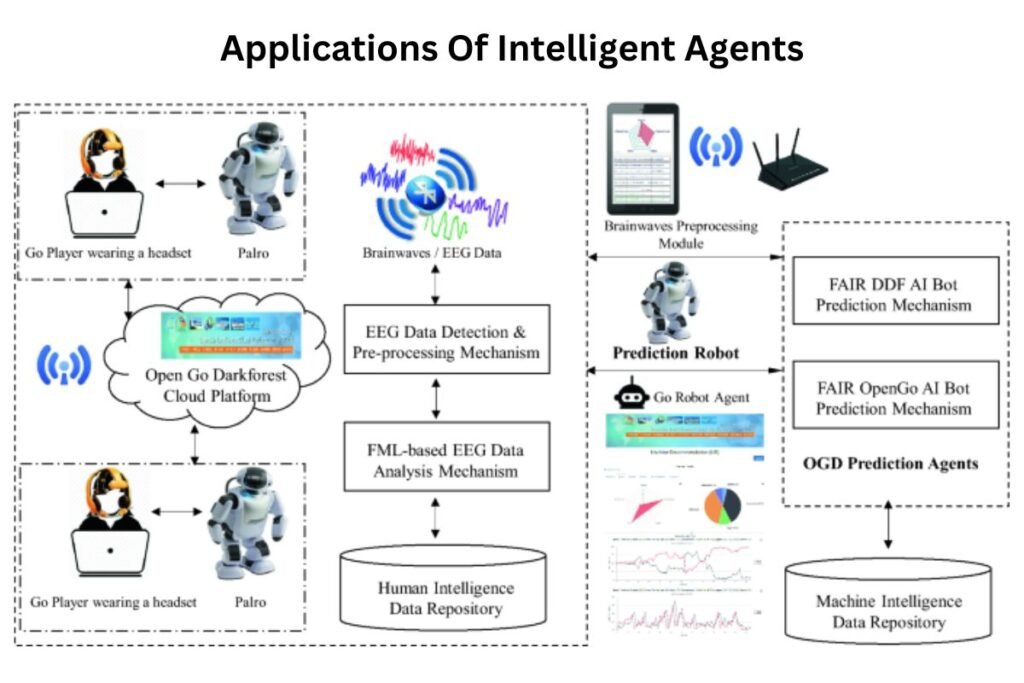
Some of the examples of how intelligent agents are used in different fields or how they are helping are:
Information access and navigation
Intelligent agents can better access and navigate information by searching, getting, and sorting excellent and accurate information from significant and different sources on the Internet. They can also help users to find the best offers, compare prices, or book tickets online. For instance, Kasbah is an agent place for buying and selling things, where users can make agents that talk on their behalf with other agents.
Decision support and empowerment
Intelligent agents can support and empower people who work with knowledge, especially in making choices, by giving them quick, right, and complete information, analysis, and advice. They can also help them improve their work, output, and speed by doing or making some of their tasks more accessible, such as creating schedules, plans, or watching. For example, the Distributed AI System for Air Traffic Control is a multi-agent system that helps air traffic controllers manage and manage the air space and ensure the flights are safe and sound.
Repetitive office activities
Intelligent agents can do some tasks done by people who work in offices, such as sales or customer support, to lower the work cost and increase the office output. They can also improve the quality and sameness of the services by dealing with usual questions, asks, or problems or by creating reports, bills, or documents. For example, the Personal Assistant for Online Services is an agent that helps users access and use different online services, such as banking, shopping, or travel, by filling out forms, sending orders, or making payments.
Mundane personal activities
Intelligent agents can help users save time and effort by taking care of some tasks, such as booking tickets, ordering food, or paying bills. They can also make their life easier and friendlier by giving them reminders, ideas, or fun based on their likes, needs, or feelings. For example, Siri is a voice-activated personal assistant that can do different user tasks, such as making calls, sending messages, setting alarms, playing music, and using natural language processing and speech recognition.
Conclusion
In conclusion, intelligent agents can perceive their environment, make decisions, and act autonomously to achieve specific goals. The design of an intelligent agent depends on several factors, such as the nature of the environment, the agent’s type, the agent’s goals, and the agent’s performance measure. The various classes of intelligent agents, including reflex agents, model-based reflex agents, goal-based agents, utility-based agents, and learning agents, provide different approaches to solving problems and achieving goals in artificial intelligence.
FAQs
What are some of the limitations of intelligent agents?
Some of the limitations of intelligent agents can include:
- They can make mistakes if their input sensors or rules must be fixed or completed.
- They can only handle situations covered by their rules or data and may not be able to adapt to new or changing situations that require learning or creativity.
- They can lack memory or state, meaning they do not remember what they saw or did before. This can limit their ability to perform tasks that require history or context.
- They cannot handle partial observability, meaning they cannot see or know everything about the environment.
- They can face ethical, social, or technical issues, such as explainability, transparency, and accountability. They may need help to justify or explain their decisions or actions, or they may not be perceived as responsible or trustworthy.
- They can face scalability or generalization problems, meaning they may need help to handle large or complex environments or tasks, or they may not be able to apply their knowledge or skills to different domains or situations.
It’s essential to consider these limitations when designing and using intelligent agents.
What are some examples of multi-agent systems in robotics?
Some examples of multi-agent systems in robotics are:
- Search and rescue robots: These are robots that work together to find and help people or animals in dangerous or disaster situations, such as fires, earthquakes, or floods. They can communicate with each other and coordinate their actions to cover large areas, overcome obstacles, and provide assistance.
- Swarm robots: These are robots that behave like social insects, such as ants, bees, or termites. They can cooperate to perform tasks beyond a single robot’s capabilities, such as building structures, exploring environments, or transporting objects. They can also adapt to changes in the habitat or the group size.
- Collaborative robots: These are robots that work with humans or other robots to perform tasks that require collaboration, such as manufacturing, assembly, or service. They can share information, skills, and resources and adjust their behaviour according to the situation and the partner. They can also provide feedback, guidance, or assistance to the human or robot partner.
How much do artificial intelligence programmers make?
According to Datamation, the average salary for an artificial intelligence programmer is between $100,000 and $150,000. AI engineers, on the other hand, earn an average of $171,715, with the top earners making more than $250,000.
How many types of agents are defined in artificial intelligence?
There are different ways to classify the types of agents in artificial intelligence. Still, one standard method is to group them into five classes based on their degree of perceived intelligence and capability. These are simple reflex agents, model-based reflex agents, goal-based agents, utility-based agents, and learning agents.

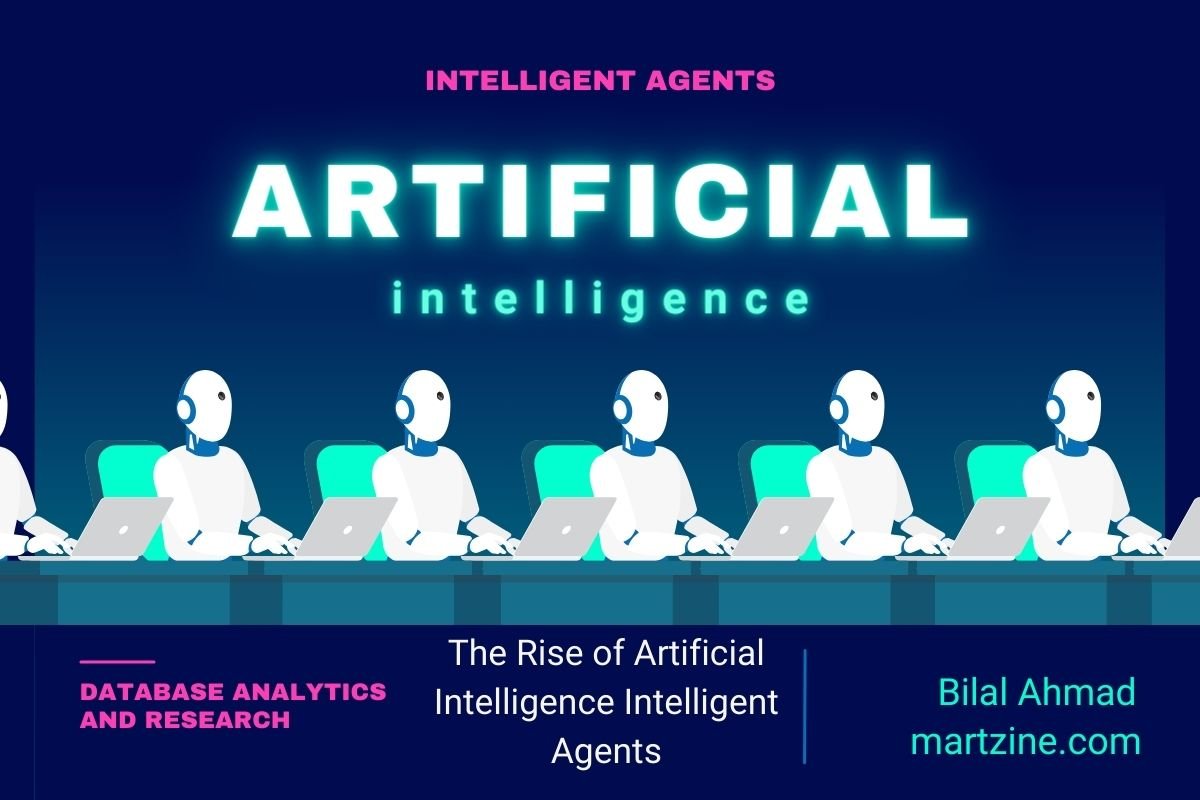

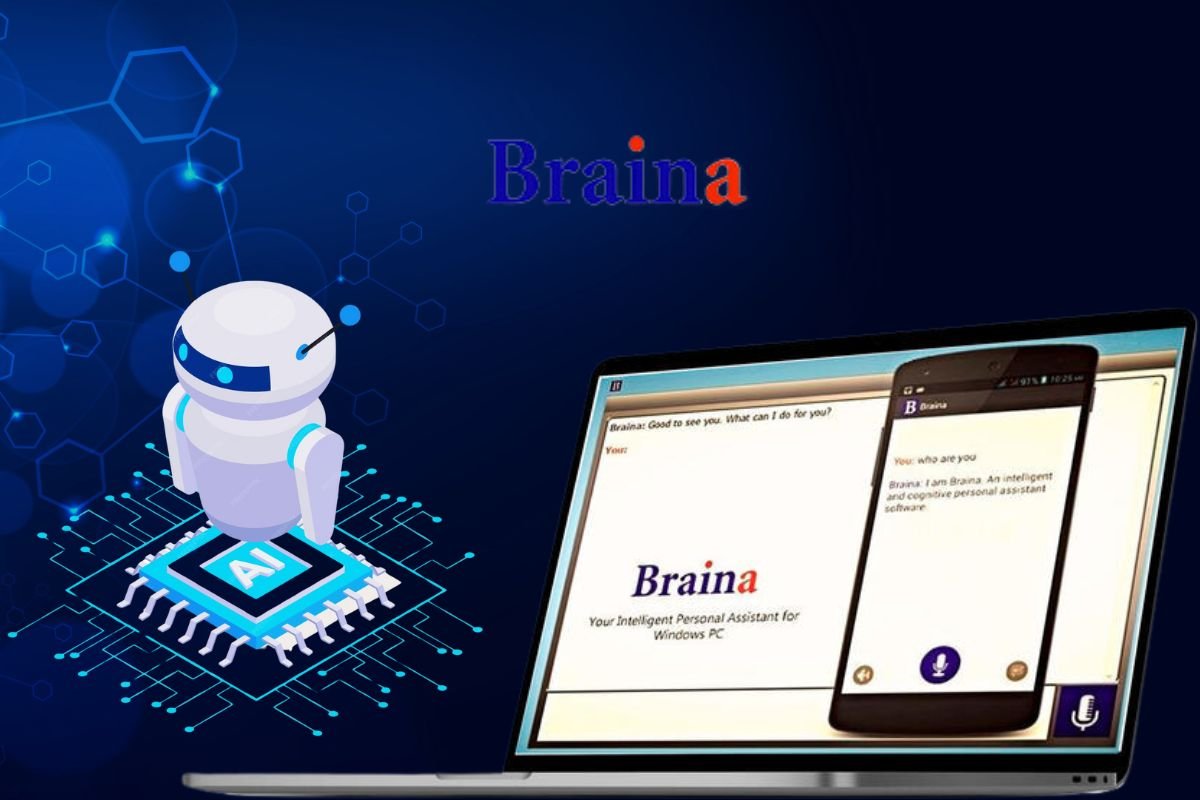

Pingback: The Future Of AI In Gaming - Martzine Entrepreneurs Hub